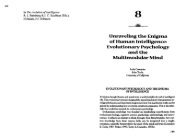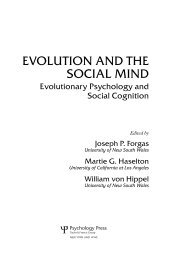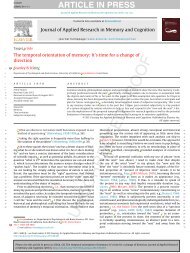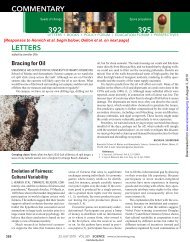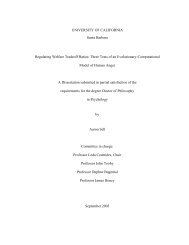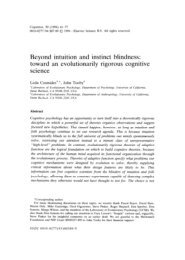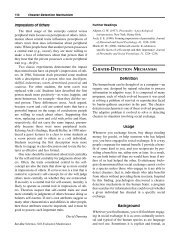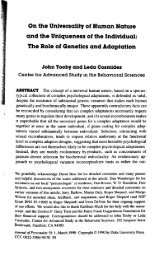Cinderella Effect: The Facts - Center for Evolutionary Psychology
Cinderella Effect: The Facts - Center for Evolutionary Psychology
Cinderella Effect: The Facts - Center for Evolutionary Psychology
Create successful ePaper yourself
Turn your PDF publications into a flip-book with our unique Google optimized e-Paper software.
<strong>The</strong> <strong>Cinderella</strong> effect - 4<br />
rate of 3.8 per million coresiding parent-child dyads per annum, while the corresponding rate <strong>for</strong><br />
stepparents was 8.4 times greater at 31.7 deaths per million dyads per annum (Daly & Wilson 2001).<br />
Because these estimates include all parental and stepparental killings, many of which have different<br />
typologies and different risk factors than fatal batterings, they are not strictly comparable to the<br />
Canadian, British and Australian numbers discussed above, but they certainly suggest that the magnitude<br />
of <strong>Cinderella</strong> effects may vary considerably across countries (see also Temrin et al. 2004).<br />
How and why <strong>Cinderella</strong> effects vary in magnitude are important questions <strong>for</strong> future research, and we<br />
are going to need cross-national research that differentiates homicide typologies to get the answers.<br />
Fatal batterings are clearly different, <strong>for</strong> example, from murder-suicides by depressed parents, who may<br />
even construe the killing of their children as a “rescue”, and in both Canada and Britain, stepparents are<br />
overrepresented as killers to a much lesser extent in murder-suicides and familicidal massacres than in<br />
fatal batterings (Daly & Wilson 1994; Wilson et al. 1995). As regards the specific case of Sweden,<br />
Daly & Wilson (2001: 294) speculate that “it may well be the case that the modern Swedish welfare<br />
state provides a social climate in which stepparents do not experience, and thus do not resent, heavy<br />
pseudoparental obligation”. Whether social policy indeed has such effects on the incidence of family<br />
violence is an important question that will require more sophisticated analyses than have yet been<br />
undertaken.<br />
Nonlethal abuse<br />
<strong>The</strong> evidence <strong>for</strong> <strong>Cinderella</strong> effects in nonlethal abuse is much more extensive than that <strong>for</strong> homicides.<br />
Numerous studies from a diversity of countries indicate that stepparents perpetrate both nonlethal<br />
physical assaults and sexual abuse at much higher rates than genetic parents.<br />
One sort of evidence comes from the case data collected by child protection agencies, in which<br />
stepfamily households and stepparent perpetrators are greatly overrepresented relative to their<br />
prevalence in the population-at-large (e.g. Creighton 1985; Creighton & Noyes 1989; Craissati &<br />
McClurg 1996; Cyr et al. 2002; Daly & Wilson 1985; Gordon 1989; Gordon & Creighton 1988;<br />
Klevens et al. 2000; Rodney 1999; Sirles & Franke 1999; Trocmé et al. 2000; Wilson et al. 1980).<br />
Another source of evidence is victimization surveys, from which comparisons can be made between the<br />
responses of those who live or <strong>for</strong>merly lived with stepparents and those raised by genetic parents. <strong>The</strong><br />
<strong>for</strong>mer routinely report much higher rates of both physical and sexual abuse (e.g. Kim & Ko 1990;<br />
Russell 1984; Sariola & Uutela 1996). Surveys of runaway youth combine the features of the criterion<br />
case study and the victimization survey, and provide further evidence. When runaway and homeless<br />
adolescents are interviewed, a very large proportion report that they have fled stepfamilies in which they<br />
were subject to abuse (e.g. Powers et al. 1990; Tyler & Cauce 2002).<br />
Are <strong>Cinderella</strong> effects byproducts of other risk factors associated with stepparenthood?<br />
That stepparents abuse and kill children at much higher per capita rates than genetic parents does not<br />
necessarily implicate the steprelationship as a causal factor. It could instead be correlated<br />
(“confounded”, in statistical jargon) with some other factor that is of more direct relevance.



